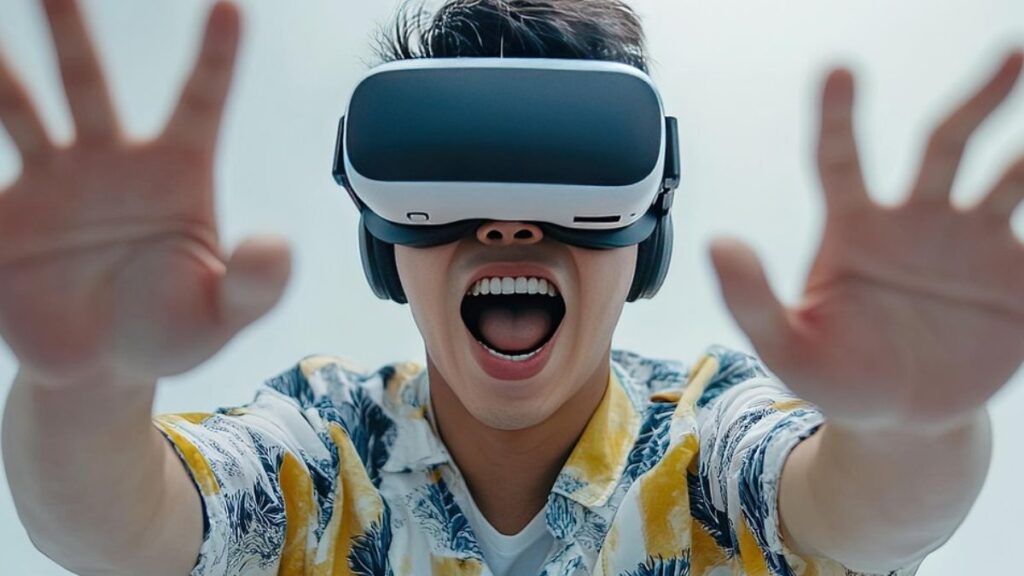In the age of endless scrolling and passive viewing, many viewers crave a deeper, more personal connection with content. Perhaps you’ve heard the buzz about Virtual Reality (VR) and wondered if it’s just a fleeting trend or a genuine media revolution. The desire for more than a flat, two-dimensional experience is growing, pushing the boundaries of what video can be. Dive into this guide to understand exactly what VR is, how it’s changing video forever, and which immersive apps you should try first!
Understanding Virtual Reality (VR)
Virtual Reality is a simulated experience that can be similar to or completely different from the real world. This technology relies on a headset that completely immerses the user by tracking their head and body movements to adjust the virtual environment in real-time. Therefore, it tricks your brain into believing you are truly present in another location.
This sense of presence is the key factor that differentiates VR from standard video. Traditional video is watched; VR is experienced. Ultimately, the user’s actions and perspective directly influence what they see.
The Core Components of a VR System
To create this convincing digital world, several components work in tandem.
- The Headset: This device contains the screens and lenses that deliver the visuals. Crucially, it blocks out the real world, ensuring full immersion.
- Tracking Sensors: These external or internal sensors detect the user’s movement. They are vital for maintaining the illusion of depth and movement within the virtual space.
- Input Devices: Handheld controllers or even hand-tracking systems allow the user to interact with the virtual environment. This interaction elevates the experience from mere viewing to active participation.
VR and the Revolution of Video Content
The question, “Is Virtual Reality the future of video?” is complex, but the answer is a resounding yes—at least for certain types of content. VR is not replacing all video, but it is creating entirely new formats that offer unparalleled immersion. This evolution is particularly visible in three major areas.
Immersive Storytelling and Cinematic VR
Gone are the days of a fixed camera angle. Cinematic VR, often shot with 360-degree cameras, places the viewer directly in the middle of the action.
- Active Viewing: You choose where to look, allowing you to discover details an editor might have otherwise hidden.
- Enhanced Empathy: Placing the viewer in the shoes of a character or witness can foster a powerful sense of connection and empathy, which is why documentaries and journalism are increasingly using VR.
- Interactive Narratives: Some VR experiences let you influence the plot, turning a film into an interactive adventure.
Transforming Education and Training
The passive act of watching a lecture video pales in comparison to actively participating in a simulation. Virtual Reality creates a risk-free learning environment that is proving highly effective.
Here’s how VR is transforming traditional video-based learning:
- Medical Training: Future surgeons practice complex procedures on virtual patients before touching a real person.
- Virtual Field Trips: Students can explore the pyramids of Giza or the surface of Mars without leaving the classroom. This is a massive leap from a simple documentary video.
- Skill Development: Firefighters and engineers can run through high-stress scenarios where mistakes are only virtual, accelerating real-world competency.
The Future of Gaming and Entertainment
Gaming is arguably the industry that propelled VR into the mainstream. The unparalleled depth and control offered by a headset and controllers is fundamentally changing what a game can be. Entertainment is also expanding beyond gaming, encompassing virtual concerts and social spaces.
- Live Events: You can attend a concert or a sports match from the best seat in the house—a virtual seat, of course.
- Social VR: Platforms allow friends to meet as avatars in virtual lounges, watching content together as if they were in the same room.
Challenges and the Road Ahead
While the potential of Virtual Reality is undeniable, the technology still faces hurdles before it becomes a household staple like the television. Addressing these challenges is crucial for its long-term success as the future of video.
Key areas that need improvement include:
- Accessibility and Cost: High-quality VR headsets can still be expensive, creating a barrier to entry for the average consumer. Furthermore, powerful PCs are often necessary for the most advanced experiences.
- Hardware Comfort: Headsets are becoming lighter, yet prolonged use can still lead to discomfort or motion sickness for some users.
- Content Volume: While growing, the library of high-quality, must-see VR content still needs to expand to justify the cost of the hardware for a wider audience. We need more experiences that truly leverage the unique aspects of Virtual Reality.
Top Apps for Your First Virtual Reality Experience (Guia de Apps)
Ready to dive in? The best way to understand the power of Virtual Reality is to try it. As a resource for app discovery, Guia de Apps recommends the following applications to get you started with immersive video and interactive content.
Educational and Exploratory Apps
| App Name | Category | Why You Should Try It |
| Google Earth VR | Travel/Exploration | Fly anywhere on Earth. Witness the Grand Canyon or walk the streets of Tokyo in full scale. |
| Anatomy Explorer 2020 | Learning/Science | Step inside the human body. This app allows you to manipulate and examine organs in 3D. |
| Mission: ISS | Simulation/Science | Experience life aboard the International Space Station, learning how astronauts live and work in zero-gravity. |
Entertainment and Social Apps
| App Name | Category | Why You Should Try It |
| YouTube VR | Video Streaming | Watch standard and 360-degree videos in a virtual theatre environment. Perfect for dipping your toe into VR video. |
| Beat Saber | Gaming/Rhythm | A highly popular, high-energy rhythm game that demonstrates VR’s potential for active, engaging entertainment. |
| Rec Room | Social/Gaming | A free platform for meeting friends, playing simple games, and watching media together in custom virtual spaces. |
The Verdict on Virtual Reality
Ultimately, Virtual Reality is not merely an upgrade to existing video technology; it is a paradigm shift. It introduces immersion, presence, and interactivity to content consumption. While 2D video will always have its place for casual viewing, VR is establishing itself as the premier medium for experiences that require deep engagement, whether for professional training, immersive storytelling, or next-level entertainment. You no longer just watch the video; you live it.



